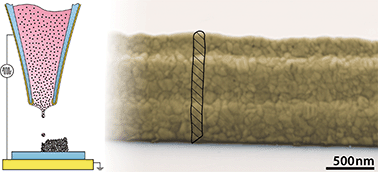3D electrohydrodynamic printing and characterisation of highly conductive gold nanowalls†
Abstract
3D printing research targets the creation of nanostructures beyond the limits of traditional micromachining. A proper characterisation of their functionalities is necessary to facilitate future implementation into applications. We fabricate, in an open atmosphere, high-aspect-ratio gold nanowalls by electrohydrodynamic rapid nanodripping, and comprehensively analyse their electronic performance by four-point probe measurements. We reveal the large-grained nanowall morphology by transmission electron microscopy and explain the measured low resistivities approaching those of bulk gold. This work is a significant advancement in contactless bottom-up 3D nanofabrication and characterisation and could also serve as a platform for fundamental studies of additively manufactured high-aspect-ratio out-of-plane metallic nanostructures.



 Please wait while we load your content...
Please wait while we load your content...